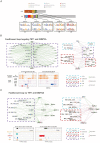Identification of DNA motifs that regulate DNA methylation
- PMID: 31334813
- PMCID: PMC6649826
- DOI: 10.1093/nar/gkz483
Identification of DNA motifs that regulate DNA methylation
Abstract
DNA methylation is an important epigenetic mark but how its locus-specificity is decided in relation to DNA sequence is not fully understood. Here, we have analyzed 34 diverse whole-genome bisulfite sequencing datasets in human and identified 313 motifs, including 92 and 221 associated with methylation (methylation motifs, MMs) and unmethylation (unmethylation motifs, UMs), respectively. The functionality of these motifs is supported by multiple lines of evidence. First, the methylation levels at the MM and UM motifs are respectively higher and lower than the genomic background. Second, these motifs are enriched at the binding sites of methylation modifying enzymes including DNMT3A and TET1, indicating their possible roles of recruiting these enzymes. Third, these motifs significantly overlap with "somatic QTLs" (quantitative trait loci) of methylation and expression. Fourth, disruption of these motifs by mutation is associated with significantly altered methylation level of the CpGs in the neighbor regions. Furthermore, these motifs together with somatic mutations are predictive of cancer subtypes and patient survival. We revealed some of these motifs were also associated with histone modifications, suggesting a possible interplay between the two types of epigenetic modifications. We also found some motifs form feed forward loops to contribute to DNA methylation dynamics.
© The Author(s) 2019. Published by Oxford University Press on behalf of Nucleic Acids Research.
Figures





References
-
- Lienert F., Wirbelauer C., Som I., Dean A., Mohn F., Schübeler D.. Identification of genetic elements that autonomously determine DNA methylation states. Nat. Genet. 2011; 43:1091–1097. - PubMed
-
- Stadler M.B., Murr R., Burger L., Ivanek R., Lienert F., Schöler A., van Nimwegen E., Wirbelauer C., Oakeley E.J., Gaidatzis D. et al. .. DNA-binding factors shape the mouse methylome at distal regulatory regions. Nature. 2011; 480:490–495. - PubMed
Publication types
MeSH terms
Substances
LinkOut - more resources
Full Text Sources

